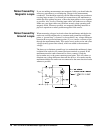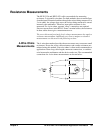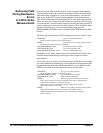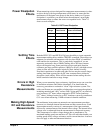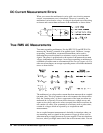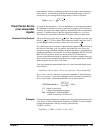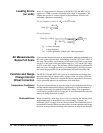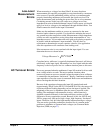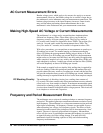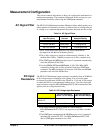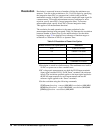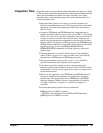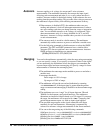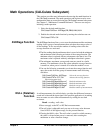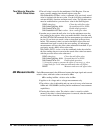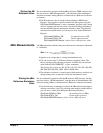
36 HP E1312A/E1412A Multimeter Application Information Chapter 2
AC Current Measurement Errors
Burden voltage errors, which apply to dc current, also apply to ac current
measurements. However, the burden voltage for ac current is larger due to
the multimeter’s series inductance and your measurement connections. The
burden voltage increases as the input frequency increases. Some circuits
may oscillate when performing current measurements due to the
multimeter’s series inductance and your measurement connections.
Making High-Speed AC Voltage or Current Measurements
The multimeter’s ac voltage and ac current functions implement three
different low-frequency filters. These filters allow you to trade low
frequency accuracy for faster reading speed. The fast filter settles in
0.1 seconds, and is useful for frequencies above 200Hz. The medium filter
settles in 1 second, and is useful for measurements above 20Hz. The
slow filter settles in 7 seconds, and is useful for frequencies above 3Hz.
With a few precautions, you can perform ac measurements at speeds up to
50 readings per second. Use manual ranging to eliminate autoranging
delays. By setting the preprogrammed settling (trigger) delays to 0, each
filter will allow up to 50 readings per second. However, the measurement
might not be very accurate since the filter is not fully settled. In applications
where sample-to-sample levels vary widely, the medium filter (20Hz) will
settle adequately at almost 1 reading per second, and the fast filter (200Hz)
will settle adequately at almost 10 readings per second.
If the sample-to-sample levels are similar, little settling time is required for
each new reading. Under this specialized condition, the medium filter will
provide reduced accuracy results at 5 readings per second, and the fast filter
will provide reduced accuracy results at 50 readings per second. Additional
settling time may be required when the dc level varies from sample to sample.
DC Blocking Circuitry The multimeter’s dc blocking circuitry has a settling time constant of
0.2 seconds. This time constant only affects measurement accuracy when dc
offset levels vary from sample to sample. If maximum measurement speed
is desired in a scanning system, you may want to add an external dc blocking
circuit to those channels with significant dc voltages present. This circuit can
be as simple as a resistor and a capacitor.
Frequency and Period Measurement Errors
The multimeter uses a reciprocal counting technique to measure frequency
and period. This method generates constant measurement resolution for any
input frequency. The multimeter’s ac voltage measurement section performs
input signal conditioning. All frequency counters are susceptible to errors
when measuring low-voltage, low-frequency signals. The effects of both
internal noise and external noise pickup are critical when measuring “slow”
signals. The error is inversely proportional to frequency. Measurement
errors will also occur if you attempt to measure the frequency (or period) of
an input following a dc offset voltage change. You must allow the
multimeter's input dc blocking capacitor to fully settle before making
frequency measurements.



